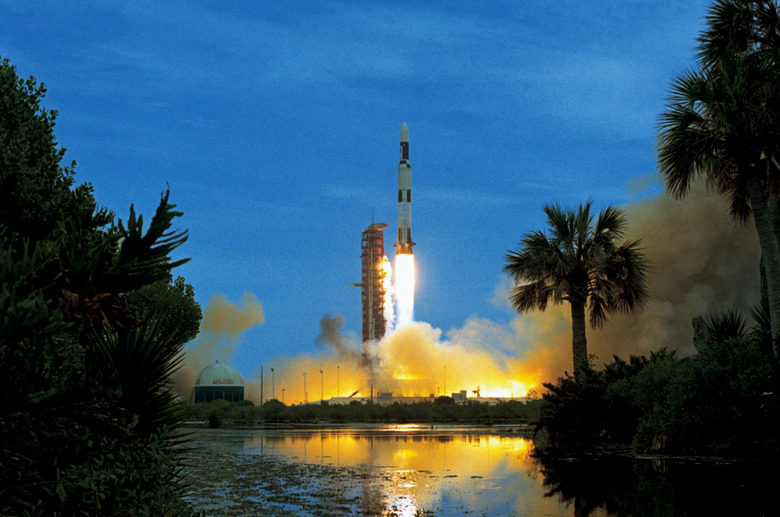Using Newton's Third Law To Explain How A Rocket Accelerates
Sir Isaac Newton's Three Laws of Motion, which form much of the basis of classical physics, revolutionized science when he published them in 1686. The First Law states that every object remains at rest or in motion unless a force acts on it. The Second Law shows why force is the product of a body's mass and its acceleration. The Third Law, familiar to anyone who has ever been in a collision, explains why rockets work.
Newton's Third Law
Newton's Third Law
Stated in modern language, Newton's Third Law says every action has an equal and opposite reaction. For example, when you're stepping out of a boat, the force your foot exerts on the floor propels you forward while at the same time exerting an equal force on the boat in the opposite direction. Because the frictional force between the boat and the water isn't as great as that between your shoe and the floor, the boat accelerates away from the dock. If you forget to account for this reaction in your movements and timing, you could end up in the water.
Rocket Thrust
Rocket Thrust
The force that propels a rocket is provided by the combustion of the rocket's fuel. As the fuel combines with oxygen, it produces gases that are directed through exhaust nozzles on the rear of the fuselage, and each molecule that emerges accelerates away from the rocket. Newton's Third Law requires this acceleration be accompanied by a corresponding acceleration of the rocket in the opposite direction. The combined acceleration of all the molecules of oxidized fuel as they emerge from the rocket's nozzles create the thrust that accelerates and propels the rocket.
Applying Newton's Second Law
Applying Newton's Second Law
If only one molecule of exhaust gas were to emerge from the tail, the rocket wouldn't move, because the force exerted by the molecule isn't enough to overcome the rocket's inertia. In order to make the rocket move, there must be many molecules, and they must have sufficient acceleration, as determined by the speed of combustion and the design of the thrusters. Rocket scientists use Newton's Second Law to calculate the thrust required to accelerate the rocket and send it on its planned trajectory, which may or may not involve escaping Earth's gravitation and going into space.
How to Think Like a Rocket Scientist
How to Think Like a Rocket Scientist
Thinking like a rocket scientist involves figuring out how to overcome the forces preventing a rocket from moving — primarily gravity and aerodynamic drag — with the most efficient use of fuel. Among the relevant factors are the weight of the rocket — including its payload — which decreases as the rocket uses fuel. Complicating the calculations, the drag force increases as the rocket speeds up, while at the same time it decreases as the atmosphere becomes thinner. To calculate the force propelling the rocket, you need to factor in, among other things, the combustion characteristics of the fuel and the size of each nozzle aperture.
Cite This Article
MLA
Deziel, Chris. "Using Newton's Third Law To Explain How A Rocket Accelerates" sciencing.com, https://www.sciencing.com/using-newtons-third-law-explain-rocket-accelerates-14164/. 24 April 2017.
APA
Deziel, Chris. (2017, April 24). Using Newton's Third Law To Explain How A Rocket Accelerates. sciencing.com. Retrieved from https://www.sciencing.com/using-newtons-third-law-explain-rocket-accelerates-14164/
Chicago
Deziel, Chris. Using Newton's Third Law To Explain How A Rocket Accelerates last modified March 24, 2022. https://www.sciencing.com/using-newtons-third-law-explain-rocket-accelerates-14164/
